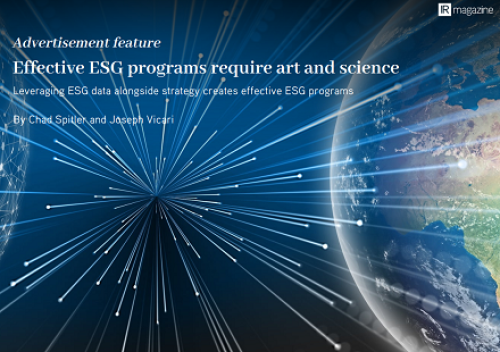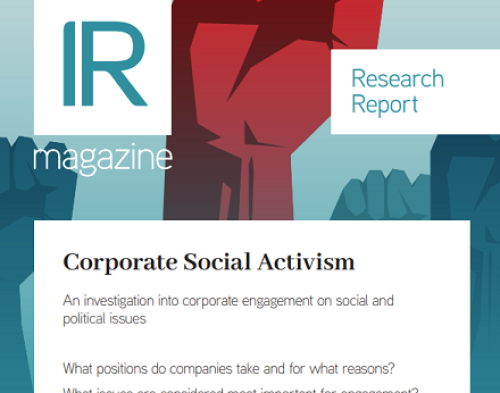Environmental and social (E&S) shareholder proposals – covering issues such as climate change and political spending –outnumbered governance proposals in the US last year for the ‘first time in a generation’, according to ISS Corporate Solutions.
In 2017, E&S proposals accounted for 54 percent of all ESG proposals in the US, whereas in 2012 they accounted for 39 percent, according to data ISS Corporate Solutions has shared with IR Magazine. The number of E&S proposals has increased by 41 percent during this five-year period, while fewer governance proposals have been filed.
‘The dip in governance resolutions likely reflects the fact that reforms such as proxy access, board declassification and repealing poison pills have taken hold across a wide swath of US companies, and so fewer companies are being targeted for governance reforms,’ Leah Rozin, principal ESG adviser at ISS Corporate Solutions, tells IR Magazine. ‘By contrast, environmental and social resolutions continue to climb, and we expect this trend to continue into 2018.’
ISS’ proxy advisory business announced last month that it was launching an E&S QualityScore separate from the governance QualityScore due to ‘growing demand from institutional investor clients’.
| Year | E&S proposals | Governance proposals | Percentage of ESG proposals on E&S issues |
| 2017 | 452 | 382 | 54.2% |
| 2016 | 432 | 516 | 45.6% |
| 2015 | 450 | 538 | 45.5% |
| 2014 | 433 | 474 | 47.7% |
| 2013 | 375 | 541 | 40.9% |
| 2012 | 319 | 489 | 39.5% |
Source: ISS Corporate Solutions
Rozin says climate change dominates environmental-focused shareholder proposals, while political lobbying spend and gender pay ratios are the two big issues in social proposals.
‘Expect demands for climate change disclosure to play a prominent role this proxy season,’ Rozin says. There have already been 18 shareholder proposals asking for a report providing a 2° Celsius scenario analysis,’ she adds. Three such proposals were successful last year, at ExxonMobil, PPL Corporation and Occidental.
Rozin adds that interest in political lobbying spend normally drops off in non-election years, but the number of proposals with this focus has continued to increase since the 2016 election.
Linking to executive compensation
Investors are increasingly looking to link executive compensation to non-financial metrics, with the number of proposals filed so far in 2018 already outstripping any previous year. So far this year there have been 14 proposals asking for ESG links to executive compensation placed on the ballot, two withdrawn and two omitted. The previous year with the most proposals of this nature was 2016, when nine made it to the ballot, four were withdrawn and one was omitted.
Those in favor of linking executive compensation to ESG performance ‘argue that effectively managing sustainability issues offers opportunities for the company, and that linking sustainability metrics to executive compensation could reduce risks related to sustainability underperformance, incentivize employees to meet sustainability goals and achieve resultant benefits, and increase accountability,’ Rozin says, adding that the companies that link ESG criteria to executive compensation perform better on average on the E&S QualityScore.
Shareholder engagement
The data shared with IR Magazine also suggests the effectiveness of shareholder engagement may be faltering. Last year, the share of proposals withdrawn fell to 18 percent – the first time it has been under 20 percent in more than a decade.
‘Withdrawals are generally seen as a by-product of productive engagement between companies and shareholder proponents, so the numbers suggest a hardening of positions or the prospect of less engagement,’ Rozin says. ‘Moreover, individual investor proponents, such as this year’s top filer, John Chevedden, are typically less likely to withdraw resolutions, which may mean the final 2018 withdrawal rate falls below that for last year.’
| Year | Percentage of withdrawals |
| 2018 to date | 11% |
| 2017 | 18% |
| 2016 | 22% |
| 2015 | 24% |
| 2014 | 24% |
| 2013 | 26% |
| 2012 | 23% |
| 2011 | 26% |
| 2010 | 21% |
| 2009 | 24% |
| 2008 | 26% |
Source: ISS Corporate Solutions
According to IR Magazine’s Global Roadshow Report 2017, 94 percent of US public companies go out on the road to meet with investors, participating in an average of 7.3 roadshows per year and spending 14.5 days on the road annually.










